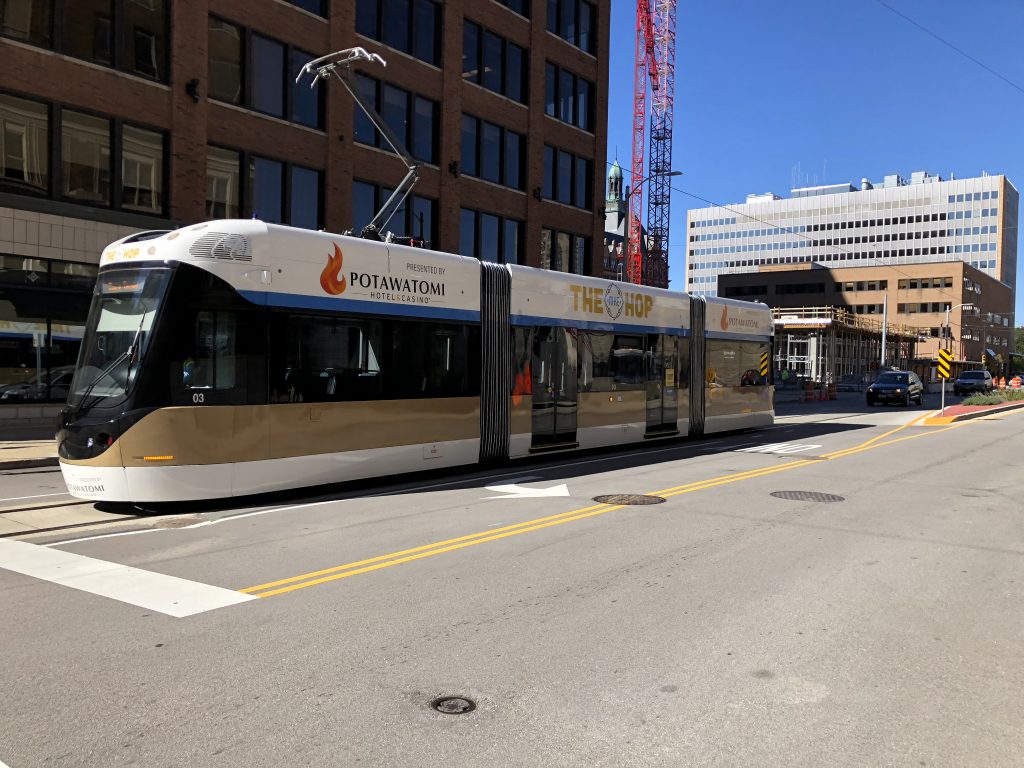11 Things to Know Before You Ride The Hop
How many people will ride it? How is it free? Oh so many questions, all answered here.
Milwaukee’s 2.1-mile-long streetcar system will open to the public beginning Friday, November 2nd at 1 p.m. A ribbon-cutting ceremony at Cathedral Square Park will precede the opening.
The Hop presented by Potawatomi Hotel & Casino, as the system is now officially known, has been debated for years. While you wait in line to board the train, use our guide to brush up on streetcar history and learn how the line could be extended.
1. How many people will ride the system?
The line is likely to be exceptionally busy for the first few weeks, but once things level out, the city projects 1,800 daily rides on the 2.1-mile line.
The number wasn’t pulled from thin air. It’s the result of a model developed using existing bus ridership data, commercial space data, housing and hotel data and indexing to existing streetcar systems. Ridership on the vehicles will be counted by sensors in the doors.
Ridership on similar systems launched since the city produced its estimate provides some amount of guidance on how the Milwaukee system might fare. In Kansas City, the most successful new system, ridership has far exceeded initial projections with 5,806 rides per day on the free system since its 2016 launch. In Cincinnati, where a new mayor was elected and attempted to shut down the system, ridership has lagged estimates and is in decline. The Cincinnati line is averaging just over 2,000 rides per day.
2. Does the streetcar have a schedule?
Not really. The operators are relying on a schedule to operate the system, but no public schedule has been released. Project officials have promised a schedule within two weeks of the line opening, but no firm date has been released.
More important in a world of smartphones and countdown clocks on stations, real-time location data won’t be available until December according to project representatives. The system is intended to deliver vehicle location and estimated arrival time information, but the stations don’t have digital displays to communicate that data with the public. Patrick J. Flaherty, who serves as the city’s owner’s representative on the project, said at a recent meeting that once the data is available app developers would be able to incorporate it into third-party applications. Flaherty also said the city has approached Milwaukee County Transit System about having streetcar location data available in the MCTS app.
3. Will the streetcar ever be extended?
Yes. In fact, the first extension, a line to the lakefront via E. Michigan St. and E. Clybourn St. is scheduled to open in 2020. It was funded in part by a federal grant that the city had to apply for multiple times before winning it. The $128.1 million cost figure for the streetcar includes the lakefront extension.
Extensions beyond the Lakefront Line are more iffy. The council approved an extension up N. Vel R. Philips Ave. to the Fiserv Forum in 2016, but it is contingent on the city receiving a $20 million federal grant. The city has applied and been denied multiple times on a grant for that line, but that doesn’t mean it will never happen. The city could also look to fund short extensions by itself through the use of tax-incremental financing districts. Portland has done this in the past to advance its now significant system. Seattle has also built an extensive system over time.
Should there be a new presidential administration in 2020, it could perhaps redo the scoring metrics for transit grants. Since the funds were first awarded to Milwaukee in 1991, each administration has altered how the Federal Transit Administration awards grants.
4. Can the streetcar run in snow?
Yes. Similar vehicles regularly operate in Detroit, Toronto and Minneapolis.
5. How is the system free to ride?
When you climb aboard The Hop, you’ll notice you don’t have to buy a ticket. Due to a federal grant for startup transit systems and a $10-million, 12-year sponsorship agreement with the Potawatomi Hotel & Casino, the system will be free to ride for the first year. And even if you tried to pay, you wouldn’t find anywhere to put your money.
City officials have said they intend to start charging $1 per ride for the system in the future, but the vehicles today don’t have a fare collection system and the city has yet to issue a request for proposals to procure one.
Should they ever do so, it’s likely riders still would rarely have their tickets checked. Numerous rail transit systems rely on a proof-of-payment system where system officials periodically board vehicles to check tickets and issue fines for non-compliance. Proof-of-payment is intended to be more cost effective then paying a conductor to ride the vehicle full time in addition to the operator.
Fares aren’t budgeted to cover more than 20 percent of the system’s approximately $3.5 million annual operating budget. The Milwaukee County Transit System recovered 28 percent of its costs from fares in 2017.
6. Did the city lay off cops to pay for the streetcar?
No. A contentious 2018 budget debate, which resulted in the elimination of positions in the Milwaukee Fire Department and Milwaukee Police Department, had the streetcar once again become a public punching bag. That anger, at least for a few years, was misplaced. Due to a federal grant and the Potawatomi sponsorship, no streetcar operating expenses appear in the 2018 budget. Similarly, no expenses appear in the 2019 budget that Barrett presented to the council in September.
The streetcar plan approved in late 2014 includes the eventual use of the parking fund to help sustain the approximately $3.5 million annual operating cost.
7. How old is the idea for a streetcar?
If you ever find yourself needing evidence things move slowly in Milwaukee, point to this. The federal funds used to build the streetcar were originally allocated to Milwaukee in 1991. The $289 million was originally intended to build a regional transit system with dedicated lanes along Interstate 94. The system would have run through the district of then-state senator Tom Barrett, who had a mustache and no grey hair at the time.
That regional plan was ultimately rejected. A compromise between Mayor John Norquist, Governor Tommy Thompson and County Executive Tom Ament in 1999 sent $149.5 million to road projects, including tearing down the Park East Freeway and $91.5 million for downtown circulator system. The federal government took the remaining $48 million back.
In 2006, the Common Council approved a $300 million guided bus system that would have leveraged the $91.5 million funding. Barrett vetoed the proposal. Barrett and then-County Executive Scott Walker spent years battling over how to use the funds.
Barrett, utilizing his allies in DC, was finally able to end the stalemate in 2009 by getting Senator Herb Kohl and Representative David Obey to split the money between the city and county. Federal legislation allocated $54.9 million to the city for a fixed guideway system (60 percent) and $36.6 million to Milwaukee County for buses (40 percent).
The Common Council approved the streetcar plan in 2011, and again in late 2014. A much, much smaller system than originally intended will finally open 27 years later when Barrett, now mustache-less and entirely gray, cuts the ribbon.
8. Why doesn’t the streetcar go to X?
The Hop’s route has been debated for years. It’s been debated for so many years that the purchasing power of the original federal allocation has declined significantly. Inflation adjusted, which the federal funds were not, today’s $54.9 million should have been $102.4 million. But because of inaction on the part of local and state officials, it was not.
The reason this matters is because the project was so reliant on the federals funds (similar to a highway interchange), that it could have been much larger if the funds were used when they were first available. The $289 million, allocated in 1991, would have bought a $542 million system in today’s dollars. That could have connected the airport, Miller Park (or then County Stadium), the arena, UW-Milwaukee, Marquette University and much more.
The reduced purchasing power, and utility law changes, set the limit at approximately two miles. The short route, with its twists and turns, connects about as many jobs, residences and hotels as possible. It’s easy to assume that a longer line would bring substantially more utility, but it’s hard to find a more logical two mile route to start with.
9. Has anyone lost an election because of The Hop?
No. Despite polling data from the Marquette Law School that showed the streetcar to be quite unpopular while it was under construction, not a single elected official that voted for the street has lost a race to a streetcar opponent.
Alderman Robert Donovan attempted to make it a key issue in his campaign for mayor against Barrett and lost by 20 points.
Chantia Lewis defeated streetcar opponent Robert Puente in 2016 for a council seat on the northwest side and has since voted for a plan to extend the line. Cavalier Johnson, who previously worked for Barrett, won an open seat that was previously held by streetcar opponent Joe Davis, Sr. and did the same. Jose G. Perez ousted streetcar supporter Jim Witkowiak in 2012, but has voted multiple times to advance the system.
Russell W. Stamper, II and Khalif Rainey replaced streetcar supporters Willie Hines and Willie Wade and both relative newcomers have voted for the project. Finally, Mark Borkowski replaced the late Joe Dudzik and has continued the late alderman’s adamant opposition to the system.
10. What about lawsuits regarding crashes on the tracks?
There actually are no pending lawsuits regarding pedestrians, motorists, bicyclists or motorcycle riders yet. However, Hupy & Abraham has expressed a willingness to represent those that would like to sue the city for incidents involving the streetcar and some individuals have started the process to do so. To sue the government in this case, one must first post a notice of injury, and a handful on individuals have done so.
City officials have been fairly tight lipped on the matter, but assistant city attorney Jan Smokowicz expressed confidence before the streetcar implementation committee regarding the city’s legal position on the proper implementation of tracks in city streets.
11. Whatever happened to the $70 million in utility costs?
When the Common Council first voted on the project in 2011, it stopped short of fully endorsing the project to start construction because of potential utility relocation costs. We Energies, AT&T and a host of other utilities released statements saying they expected those costs to be $70 million given the planned route. The companies then successfully lobbied for a state law change specifically targeted at The Hop that requires Milwaukee to pay for any relocation costs associated with the system.
In response to the law change, the city heavily altered the route to avoid major utility corridors. The line goes northbound on N. Milwaukee St. and southbound on N. Broadway to avoid much of the intersection of E. Mason St. and N. Broadway, which is loaded with underground telecommunications equipment. Similarly, the route uses only N. Jackson St. instead of pairing with N. Van Buren St. to avoid a We Energies steam tunnel.
The end result? The unexpected $70 million cost was reduced to just under $12 million.
If you think stories like this are important, become a member of Urban Milwaukee and help support real independent journalism. Plus you get some cool added benefits, all detailed here.
More about the Milwaukee Streetcar
For more project details, including the project timeline, financing, route and possible extensions, see our extensive past coverage.
- Another Streetcar Collision - Jeramey Jannene - Jun 27th, 2025
- Streetcar Hit By Apparent Red Light Runner - Jeramey Jannene - Jun 16th, 2025
- Streetcar Will Run On Consolidated Route During Summerfest - Jeramey Jannene - Jun 11th, 2025
- City Hall: Milwaukee Must Replace Failing Streetcar Switches - Jeramey Jannene - Feb 24th, 2025
- Streetcar Confronts Limited Funding, Operations Challenges - Evan Casey - Jan 22nd, 2025
- Council Kills Streetcar’s ‘Festivals Line’ - Jeramey Jannene - Jul 31st, 2024
- Streetcar Will Use Festivals-Oriented Route Through Summer - Jeramey Jannene - Jul 9th, 2024
- The Hop’s Lines Will Merge For Easier Summerfest Service - Jeramey Jannene - May 30th, 2024
- Streetcar Begins Daily Service To The Couture, BRT Will Soon Follow - Jeramey Jannene - Apr 11th, 2024
- Milwaukee’s Three Streetcar Extensions Need Mayoral Direction - Jeramey Jannene - Nov 8th, 2023
Read more about Milwaukee Streetcar here
Political Contributions Tracker
Displaying political contributions between people mentioned in this story. Learn more.
- December 13, 2018 - José G. Pérez received $50 from Mark Borkowski
- June 29, 2017 - Tom Barrett received $1,000 from Herb Kohl
- March 3, 2016 - Tom Barrett received $5,000 from Herb Kohl
- September 8, 2015 - Robert Donovan received $50 from Mark Borkowski
- May 5, 2015 - José G. Pérez received $10 from Cavalier Johnson
Eyes on Milwaukee
-
Church, Cupid Partner On Affordable Housing
 Dec 4th, 2023 by Jeramey Jannene
Dec 4th, 2023 by Jeramey Jannene
-
Downtown Building Sells For Nearly Twice Its Assessed Value
 Nov 12th, 2023 by Jeramey Jannene
Nov 12th, 2023 by Jeramey Jannene
-
Immigration Office Moving To 310W Building
 Oct 25th, 2023 by Jeramey Jannene
Oct 25th, 2023 by Jeramey Jannene






















Can one take a bicycle on the Hop?
Yes. There is a storage device just inside the door.